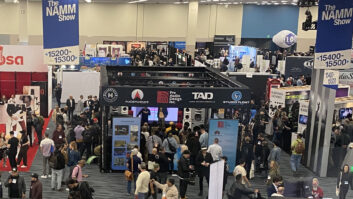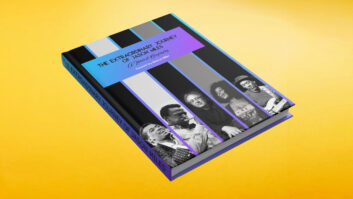Picture, if you will, one of those black-and-white 1940s movies with Judy Garland, Mickey Rooney and Huntz Hall. They’re a bunch of scruffy, lower-class kids who are always in trouble, never go to school. But, like everyone, they need money. Then, one day, they’re hanging out on his mom’s front stoop when Mickey jumps up and snaps his fingers.
“Hey, kids,” he exclaims. “I’ve got it! Let’s start a magazine!”
Okay, maybe the beginning of Mix wasn’t exactly like that, but it was close. In this case, Mickey was played by a musician and acoustics consultant named David Schwartz, and Judy was played (with appropriate dramatic flair) by vocalist Penny Jacob, who had some friends with a small recording studio in Marin County. Energetic and inquisitive (required characteristics of successful journalists), they realized one day that a large number of studios were popping up around the Bay Area, and that it might be an interesting project to create a directory of these places. Assisted by the publishers of the local music trade, BAM magazine, the two brought their vision to fruition. In the fall of 1977, The Mix was born.
The magazine was actually a tabloid, printed on newsprint and pretty funky — sort of like your weekly free newspaper. (There are studio folks out there who will proudly tell you that they still have the very first issue, and how “the ink came off on your fingers.”) But, instead of movie listings and steamy personals, this paper contained page after page of recording studios, with photos of their rooms, lists of their gear, “extras” such as hot tubs and pinball machines, and even their rates (which, oddly enough, were often approximately the same as they are today).
Yes, children, all those detailed studio listings that have become so ubiquitous in directories (and more recently on CD-ROMs and the Internet) started right here. And by the way, there turned out to be a lot more studios in the Bay Area than Penny and David imagined. So many, in fact, that it seemed only natural to scope out the scene in Los Angeles, and to publish a Southern California directory the following year. This was followed in the next couple of years by directories of studios in Nashville and New York, the Midwest, Southeast, etc. By the mid-’80s, recording folks from coast to coast had their own editions of Mix (the name was modified in 1981), and no one had an excuse for not knowing which studio in his neck of the woods had just the right console, limiter or microphone to get the job done. Book it, Danno!
Flash forward 10 years. By the late ’80s, fueled by artists such as Michael Jackson, Madonna and Bruce Springsteen, the market for recorded music had exploded into a global phenomenon. Thousands of people were making a livelihood (or trying to) in recording and music production, and Mix — by now a glossy magazine of more than 200 pages each month — had become their leading source of information on the technology and tools of the trade.
Under the editorial leadership of Schwartz, assisted by George Petersen (a rock drummer and studio junkie) and Blair Jackson (a music writer and the editor who’d come over from BAM), the Mix staff created a publication that was a cut above the technical journals of the time. There were equipment reviews and product surveys aplenty for the gearheads among us, but also features on the techniques of recording, and interviews with the engineers and producers who had become to techies what Eric Clapton and Carlos Santana were to guitar players. Readers around the world responded to Mix‘s colorful blend of personalities and technology; and by the mid-’90s, more than 50,000 copies a month were going to subscribers in more than 90 countries.
Of course, given the nature of the personalities involved and the industry itself, the only constant was change. In 1985, the magazine had acquired the fledgling publication Electronic Musician (edited by musician/technologist Craig Anderton) as a means of satisfying the information needs of the growing MIDI production field, and EM developed to become as much of a force in that market as Mix had for pro audio. And, in the same year, the publishers founded what would turn out to be Mix‘s highest-profile and perhaps most ambitious endeavor: the TEC Awards.
The Technical Excellence and Creativity Awards were born of the same awareness that led the magazine to write extensively not only about SMPTE timecode, workstations and digital converters, but about the creative people who employ those technologies in pursuit of better sound — the awareness that people and innovation are the lifeblood of successful audio production. Since the fall of 1985, when the first ceremony was held in New York City, the TEC Awards have annually honored the people, companies and products behind the recordings, tours and soundtracks that enthrall the public (and make millions for artists, record companies, film studios, promoters and others).
The people, it turned out, are what audio folks care about the most. Ever since the TEC Awards introduced its Hall of Fame (1988), followed by the Les Paul Award (1991), audio pros have turned out in increasing number each year to honor their peers. After all, what audio professional is not moved by the opportunity to hear the likes of George Martin, Phil Spector, Stevie Wonder or Brian Wilson talk about how the technical personnel, the people behind the console, helped make their greatest successes possible?
Naturally, in the movie version of Mix, the characters played by Mickey and Judy would at some point be approached by a business tycoon who would offer them vast sums of money to turn their small-time operation into a big-budget production. In real life, this figure was played by television mogul Norman Lear, who in 1989 bought Mix Publications and folded it into his media empire. Successive owners have introduced many changes, but one thing that has not changed about the magazine is its real-life connection to the audio industry. It’s that bond — the fact that Mix today is still produced by people who know the stage and studio, and the issues that matter to recording and sound professionals — that, we believe, keeps the magazine as vital as it was 25 years ago. It’s been a great run, and we hope you enjoy the show!
Hillel Resner has worked forMixsince 1979, and previously starred as associate publisher, publisher and editor-in-chief. He is currently president of the Mix Foundation for Excellence in Audio and executive producer of the TEC Awards, which will be held this year in Los Angeles on October 7.







